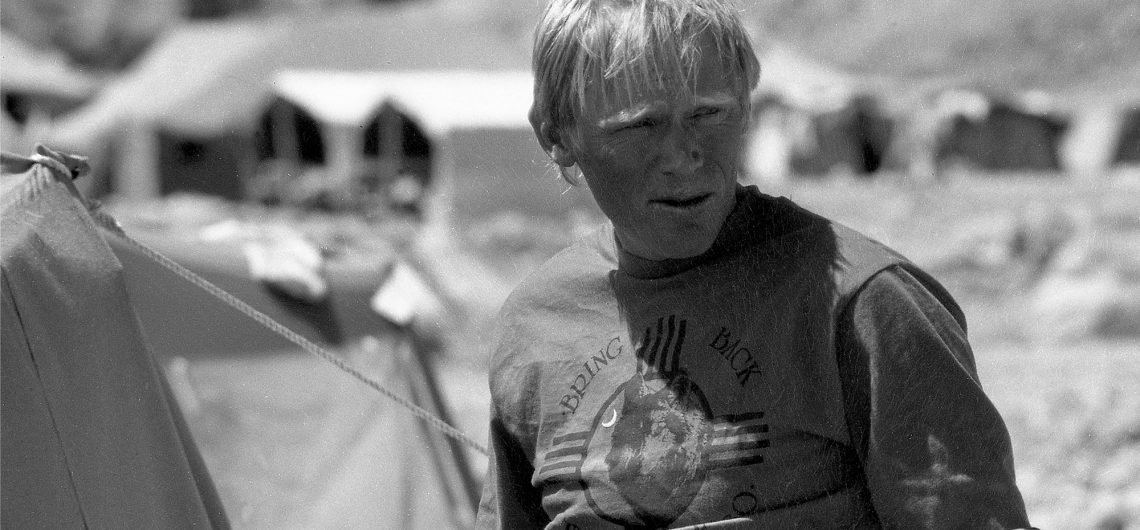Anatoli Boukreev, 39, a talented prominence following his brave rescue mission of climbers in the catastrophic Everest ascent in May 1996, was killed on Christmas Day in an avalanche on Annapurna in 1997 a year after the 1996 Everest disaster.
Boukreev and Italian climber Simone Moro, 30, were attempting to climb a new alpine route in winter on Nepal’s 26,700-foot Annapurna in the Himalayas. Dimitri Sobolev, a Russian cinematographer, was among the climbers when an avalanche, reportedly caused by a fallen cornice, engulfed the three men at roughly 19,500 feet on the mountain’s south flank. Moro was swept 800 feet down the mountain by the avalanche but managed to stay on top of it. When he straightened up, he saw no evidence of the other two men.
Boukreev and his photographer remained hopeful for more than a week as weather delayed helicopter search operations. Lt. Col. Madan K.C., most known for his heroic helicopter rescue of Beck Weathers and Makalu Gau from the summit of Everest in 1996, performed at least two helicopter search flights that yielded inconclusive findings in poor weather. Boukreev and Sobolev’s deaths were ultimately verified on January 4 when a ground party of Sherpas and Kazak climbers (Rinat Khaibullin, Surgey Oucharanko, Andrey Molotov, and Dimitri Muravyov) discovered no trace of the missing men. Nima Sherpa of Cho Oyu Trekking in Kathmandu organized most of the rescue, and the sherpa climbers who discovered Boukreev’s camera and clothing were Purba and Ang Tsering.
During the hunt, Boukreev’s American girlfriend, Linda Wylie of Santa Fe, New Mexico, traveled to Annapurna base camp. When the search group failed to locate the missing individuals, Wylie declared, “There is no longer any hope of finding him alive.” I can only pray that the searchers find his body and bury it properly in a crevice. Anatoli want to remain in the highlands.”
Boukreev was a seasoned high-altitude climber who acquired his trade via the arduous programs of the old Soviet Union’s mountain sports organization. When the Soviet Union fell apart, Boukreev turned to the West; he began guiding in the Himalayas on the side, finally joining Scott Fischer’s Mountain Madness for the May 1996 attempt on Mount Everest.
The sad and disputed events of that climb are now well known because to best-selling author Jon Krakauer’s book, Into Thin Air, and a second book, The Climb, co-authored by Boukreev and Weston DeWalt. Boukreev stated that he chose to publish his own narrative of the May 10, 1996 summit day disaster because he believed Krakauer’s story had wrongly represented his actions and objectives.
Boukreev stated in May 1997 that he was troubled by unwarranted criticism of his conduct after the Everest disaster.
To some extent, the climber was justified when The American Alpine Club awarded him the David Sowles recognition, the organization’s highest recognition for bravery, for his efforts in getting Sandy Hill Pittman, Charlotte Fox, and Tim Madsen back from a stormy South Col to Camp IV alive.
The 1996 Everest disaster catapulted Anatoli Boukreev to public notice, although his record of difficult climbs stands on its own. He was one of the most active high-altitude climbers in recent years, having climbed four 8000-meter peaks in 80 days earlier this year (Everest, Lhotse, Broad Peak, and Gasherbrum II).
When he died on Annapurna, he was attempting a nearly unheard-of 8000-meter winter effort in a contemporary, lightweight technique.
Boukreev, who owned a home in Kazakhstan’s capital of Alma Ata, has most recently resided in Santa Fe, New Mexico.
Who was Anatoli Boukreev
Anatoli Nikolaevich Boukreev born on January 16, 1958, was a Soviet and Kazakhstani climber who climbed ten of the fourteen eight-thousander peaks (those above 8,000 m (26,247 ft) without supplementary oxygen. From 1989 to 1997, he completed 18 successful ascents of peaks above 8000 meters.
Boukreev was known as an elite climber in international climbing circles for summiting K2 in 1993 and Mount Everest via the North Ridge route in 1995, as well as his solo fast ascents of some of the world’s highest mountains. He became even more well-known after saving climbers’ lives during the 1996 Mount Everest accident.
Boukreev was killed in an avalanche on a winter ascent of Annapurna in Nepal in 1997, on Christmas day.
Death
Boukreev and Simone Moro were repairing ropes in a couloir around the 5,700 m (18,700 ft) level on December 25 about midday.
A massive cornice erupted from the heights of Annapurna’s Western Wall and rumbled down the 800 m (2,600 ft) long couloir. Moro was thrown down the mountain by the avalanche and landed right above their tent at Camp I, 5,200 m (17,100 ft). Moro, fortunately, had stayed towards the top of the avalanche rubble and was able to pull himself out after a few minutes.
Moro descended to Annapurna base camp, where he was flown by helicopter back to Kathmandu for surgery on his hands, which had been ripped down to the tendons during the fall, after being unable to see or hear any signs of Boukreev or Sobolev (whom Moro had witnessed disappearing beneath “car-sized blocks of ice”).
Memorial
There is a monument chorten to Boukreev at Annapurna base camp, which has one of his favorite quotes:
“Mountains are cathedrals where I practice my religion, not stadiums where I satisfy my ambition to achieve.”
Nurlan Dalbai’s sculpture of Boukreev was presented at the Medeu ice sports arena on January 18, 2023. The climber is portrayed at repose, his hand resting on an ice axe.
![]()


Comments